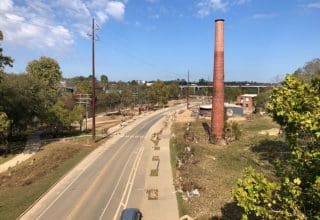Nine months after Hurricane Helene tore through the Southeast, the recovery process is just beginning. As communities rebuild their lives and towns, the Carolina Journal revisits some of the state’s hardest-hit areas to assess what recovery looks like, what’s still missing, and how far there is to go.
Asheville is likely the city most known for devastation and destruction incurred by Hurricane Helene, as it is one of the largest municipalities in the western part of the state. While much has been accomplished since Helene struck, much remains to be completed.
“We’ve come a long way in the sense that a lot of the vital services have been restored — water, power, and the road rebuilding,” Esther Manheimer, mayor of Asheville, told the Carolina Journal. “We had a lot of traffic jams all over town because so many roads were still closed. There’s still a lot of road work that needs to be done in western North Carolina. But in terms of Asheville’s functioning roads, we’ve made great progress. Now we’re kind of into the period of the longer-term recovery rebuilding.”
Helene decimated Asheville’s park system along the French Broad River. The river’s park system featured playgrounds, dog parks, trails, fields, and a golf course. The hurricane also destroyed many of Asheville’s recreational facilities, including the soccer fields and the swimming facility in East Asheville.
“We know how this has impacted each of our counties, and it’s a struggle to come back from such a severe catastrophe.”
Esther Manheimer, Asheville Mayor
For the first six months following Hurricane Helene, the Federal Emergency Management Agency (FEMA) covered 100% of recovery costs; now, FEMA is covering 90% of recovery costs, with the states covering the remaining 10%.
“The way this works is FEMA pays kind of like a giant insurance claim,” explained Manheimer. “The city has to inventory all of the damage that [was] done and then figure out the scope of work to rebuild all these facilities and get it approved by FEMA before undertaking the contracting. There’s some ability to get some funds advanced so that we do not have to carry all the expenses on our books, even though it will be reimbursed. There’s some lag time in reimbursement, so the less we must carry on us is better.”
Manheimer also explained that the city has access to additional federal funding through the Build Back Better Regional Challenge under the American Rescue Plan, signed into law by former President Joe Biden. Additional federal funding is also accessible through the Community Development Block Grants-Disaster Recovery grant (CBDG-DR).
“That’s kind of just to paint a picture of how all that funding comes together and how that works,” explained Manheimer. “That’s what we’re looking at, so all those things are kind of jelling up now. It’s a little bit of a race because some of those things have deadlines.”
“Some of those funding opportunities have upcoming deadlines, so staff are working hard to get our projects in,” said Manheimer. “We have a project to connect the North Fork Reservoir with the Bee Tree Reservoir in the eastern area that serves the city of Asheville. That will help us create some redundancy between those reservoirs.”
The cost estimate for the reservoir project is approximately $150 million. According to Manheimer, these kinds of projects will create greater resiliency for Asheville, and city officials are looking to secure federal funding for them.
During a recent Western North Carolina Recovery Committee meeting — with Gov. Josh Stein and state lawmakers present — there was a general acknowledgement of “how great it was” that the North Carolina General Assembly passed another disaster relief funding package. The Disaster Recovery Package of 2025-Part II, was passed on June 26 and was signed into law by Stein on June 27.

“The governor continues to highlight additional needs, and others on the committee did too,” said Manheimer. “There are still funds needed for local governments. I would argue that money is still needed for revenue loss for local governments, and small business recovery funds are still needed.”
Manheimer noted that the city’s biggest challenge is business recovery. She also noted that funding is still needed for highway and road repairs.
“I think one major concern that I’m hearing is the continuing need to regrow our economy and help it come out of this sort of depression induced by the storm today,” said Manheimer. “We looked at a lot of the job losses and how that’s recovering. We looked at the hit to GDP; just getting the message out that western North Carolina is open for business, and people can come and visit and do their business here. There are many things to do and experience so that we can continue regrowing jobs.”
The WNC Recovery Committee is developing a strategic plan on economic recovery in western North Carolina and diversifying the economy, with the goal of creating a more resilient economy in the future should something like Helene ever happen again.
The post Asheville mayor gives update 9 months after Hurricane Helene first appeared on Carolina Journal.
The post Asheville mayor gives update 9 months after Hurricane Helene appeared first on First In Freedom Daily.
Click this link for the original source of this article.
Author: Katherine Zehnder
This content is courtesy of, and owned and copyrighted by, https://firstinfreedomdaily.com and its author. This content is made available by use of the public RSS feed offered by the host site and is used for educational purposes only. If you are the author or represent the host site and would like this content removed now and in the future, please contact USSANews.com using the email address in the Contact page found in the website menu.








